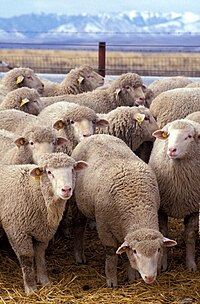
Photo from wikipedia
Background: The difference in the maternal behavior expression of sheep can affect the early growth and development as well as the survival of lambs. The characteristics of maternal behavior in… Click to show full abstract
Background: The difference in the maternal behavior expression of sheep can affect the early growth and development as well as the survival of lambs. The characteristics of maternal behavior in primiparous and multiparous ewes were observed to reveal the expression of maternal behavior in Chinese Hu sheep and its effects on early lamb survival and body weight.Methods: In total 527 pregnant ewes with delivery were selected, including 246 primiparous ewes and 281 multiparous ewes. The observation record of maternal behavior began from 10 days before delivery to 3 days after delivery by video recording. The behaviors of ewe to the lamb included licking, suckling, seeking lambs, denial of suckling after delivery, butting and trampling lambs, abandoning lambs, and stealing lambs. Body weight of lambs were recorded including newborn, 7-day-old, 14-day-old and 35-day-old (weaning).Result: There were significant differences in the incidence rate in lamb abandonment and stealing between primiparous and multiparous ewes (P less than 0.05), namely the primiparous ewe group had the higher incidence of undesirable behaviours. However, there were no significant differences in seeking, licking and trampling behaviors between two groups (P greater than 0.05). Lamb survival within 7 days after delivery of multiparous ewes was greater than primiparous ewes (P less than 0.05). The body weights of newborn and 7-day-old lambs in the multiparous ewe group were significantly higher than the primiparous group (P less than 0.05). This study demonstrates that limited significant differences exist between primiparous and multiparous ewes in several aspects of maternal behavior in Chinese Hu sheep. Ewe behavioral expression associated with the birth and care of the neonatal lambs are essential for the survival and growth of the offspring.
Journal Title: Indian Journal of Animal Research
Year Published: 2020
Link to full text (if available)
Share on Social Media: Sign Up to like & get
recommendations!